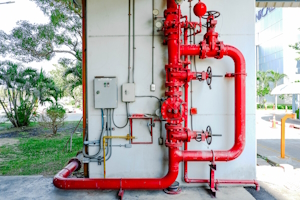What Is An NFPA-Compliant Valve

Figure 1: Hydrant systems use NFPA-certified valves to ensure reliable operation.
NFPA-compliant valves are essential parts of any fire protection system. Their design, manufacturing, and testing processes align with the National Fire Protection Association (NFPA) standards. This article overviews NFPA valves and offers guidance on acquiring NFPA compliance with valves.
What is the NFPA?
The NFPA is a global nonprofit organization founded in 1896, dedicated to reducing loss due to fire, electrical, and other hazards. It provides information and knowledge through more than 300 consensus codes and standards, research, education, and advocacy. Insurance firm representatives originally established the NFPA to standardize fire sprinkler systems, and its mission has expanded over time.
NFPA-compliant valves
NFPA valves meet the standards of the NFPA. They are used in fire safety systems to control water flow or other fire-fighting materials. The NFPA provides guidelines for various valves, including their design, installation, testing, and maintenance. Standards like NFPA 13, NFPA 14, and NFPA 20 outline the use and placement of valves in sprinkler systems and stationary pumps for fire protection. These standards help make fire protection systems more effective and reliable, protecting lives and property.
NFPA valve types
There are various valves used in fire protection systems. The following types of valves commonly have NFPA compliance. However, remember that a valve outside fire protection systems does not require NFPA compliance. For example, while an NFPA-compliant ball valve is necessary for a fire protection system, only some ball valves have NFPA compliance. Therefore, ensure a valve has compliance before selecting it.
-
Control valves: Control valves are used throughout fire protection systems: sprinkler systems, standpipes, and fire pump installations.
- Ball valves:Ball valves are known for their quick shut off, durability, and reliability, making them a popular choice for fire protection. Ball valves are commonly used in secondary parts of fire protection systems, like the test lines for fire pumps and drain lines. They're also used in sprinkler systems to quickly stop the water flow, such as at the main and auxiliary drains.
- Butterfly valves:Butterfly valves are used to regulate flow. These valves are often used in fire pump test lines and fire water storage tanks in fire protection systems. They are valued for their compact design and ease of operation.
- Check valves:Check valves are used in fire sprinkler systems to prevent the reverse water flow. These valves are necessary in multi-story buildings where gravity could cause water to flow backward.
- Gate valve:Gate valves are less commonly used because they do not operate as fast as alternative valves, such as ball and butterfly valves. However, gate valves are still used sometimes in sprinkler systems and standpipes because they provide unobstructed flow and can completely stop the flow.
- Pressure reducing valves:Pressure reducing valves are used in high-rise buildings to reduce the water pressure in the fire protection system to a manageable level. This prevents damage to the system or the building.
- Relief valves: NFPA pressure relief valves are used in fire pump systems to prevent overpressure by discharging excess pressure when it exceeds a preset level.
- Zone valve: An NFPA zone valve is a special valve used in fire sprinkler systems. This valve controls water flow in certain areas of the system, helping firefighters use water wisely in emergencies. It also allows work on parts of the system without affecting the whole system.
How to acquire NFPA-compliance for a valve
As with most standards, acquiring NFPA-compliance for valves follows a straightforward process of design, testing, documenting, and reviewing:
- Understand NFPA standards: Understand the NFPA standards related to the product. For valves, these usually include NFPA 13, 14, and 20, which are standards for installing sprinkler systems, standpipe and hose systems, and stationary pumps for fire protection, respectively. Each of these standards contains sections about valves.
- Design according to standards: The manufacturer needs to create their valves based on the guidelines outlined in the relevant NFPA standards. These include specifications for materials, valve size and type, pressure limits, and other design factors.
- Testing: After valves are made, they should be tested in a lab that can approve NFPA compliance. The tests usually check the valve's pressure levels, flow speeds, and how it works under various conditions to ensure it meets the necessary standards.
- Documentation: Keep detailed records of the design process, materials procurement, manufacturing process, and testing results. This will be necessary for the certification process and for any audits or inspections.
- Certification: Once testing is complete, the results should be submitted to an independent third-party certification body that is recognized by NFPA. This body will review the results and the valve's design and manufacturing process to certify that it is NFPA compliant.
- Regular reviews and audits: Even after the valves have been certified, regular reviews and audits are necessary to ensure continued compliance with NFPA standards. This includes regular re-testing of the valves and a review of any changes to NFPA standards.
- Training: Ensure that individuals involved in the design, manufacturing, and testing processes are properly trained and understand the NFPA standards relevant to the valves they are working with.
- Product marking: After certification, be sure to mark the product as NFPA-compliant, including the relevant standards number. This helps customers know that the product meets the required safety standards.




